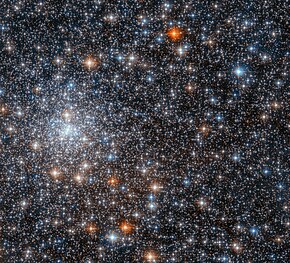NGC 6558
Appearance
| NGC 6558 | |
|---|---|
 The globular cluster NGC 6558 imaged by the Hubble Space Telescope | |
| Observation data (J2000 epoch) | |
| Class | V |
| Constellation | Sagittarius |
| Right ascension | 18h 10m 18.38s[1] |
| Declination | −31° 45′ 48.6″[1] |
| Distance | 24.1 kly (7.4 kpc)[1] |
| Apparent magnitude (V) | 11.29[1] |
| Physical characteristics | |
| Radius | 5.2' x 5.2'[2] |
| Metallicity | = -1.32[3] dex |
| Other designations | Cr 368, GCl 89, ESO 456-62, VDBH 259[1] |
NGC 6558 is a globular cluster, located about 24,000[4][a] light years away in the constellation Sagittarius. Its apparent magnitude is about 11 and its apparent diameter is about 10 arcminutes.[2] The globular cluster was discovered in 1784 by the astronomer William Herschel with his 18.7-inch telescope and the discovery was later catalogued in the New General Catalogue.
It is located 1.5 degrees south-southeast of Gamma2 Sagittarii.
References
[edit]- ^ a b c d e "NGC 6558". SIMBAD. Centre de données astronomiques de Strasbourg. Retrieved 8 January 2017.
- ^ a b "NGC 6558". Retrieved 8 January 2016.
- ^ "A Galactic Globular Clusters Database: NGC 6558". Retrieved 8 January 2017.
- ^ Souza, S. O.; Libralato, M.; Nardiello, D.; Kerber, L. O.; Ortolani, S.; Pérez-Villegas, A.; Oliveira, R. A. P.; Barbuy, B.; Bica, E.; Griggio, M.; Dias, B. (2024). "Combined Gemini-South and HST photometric analysis of the globular cluster NGC 6558. The age of the metal-poor population of the Galactic Bulge". arXiv:2407.15918 [astro-ph.GA].
In the literature, the heliocentric distance of NGC 6558 ranges from ∼6.3 kpc (Rich et al. 1998) to ∼8.3 kpc (Barbuy et al. 2018b).
- Notes
- ^ The central value in the range is 7.3 kiloparsecs (24,000 ly).
External links
[edit]

![{\displaystyle {\begin{smallmatrix}\left[{\ce {Fe}}/{\ce {H}}\right]\end{smallmatrix}}}](https://wikimedia.org/api/rest_v1/media/math/render/svg/4c0821bd80891e071c08e7c7ee8e022baedf522c)